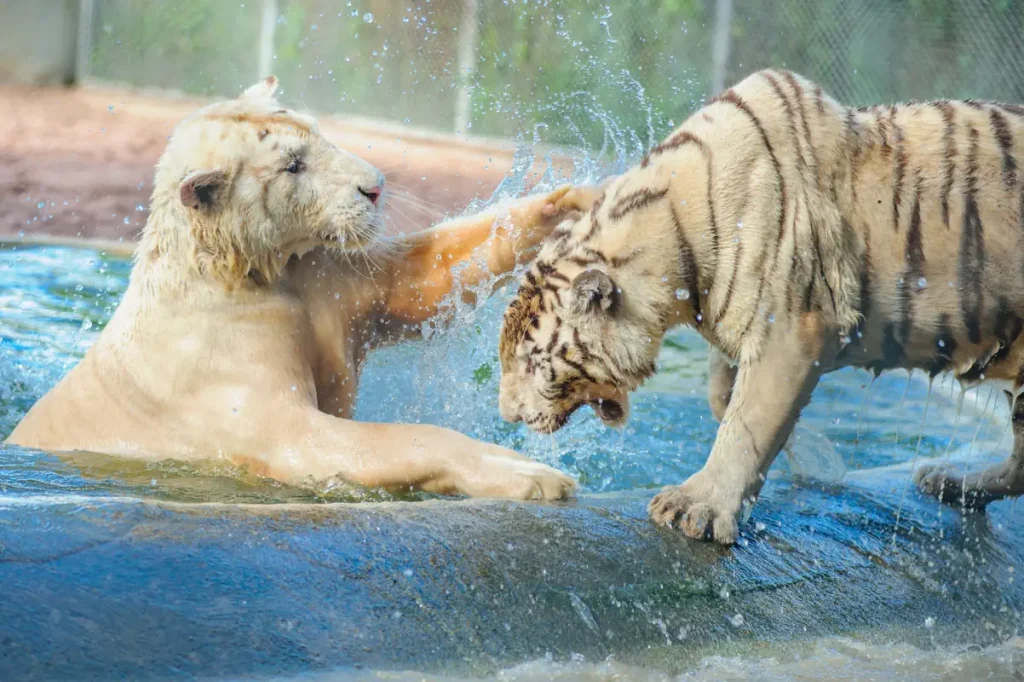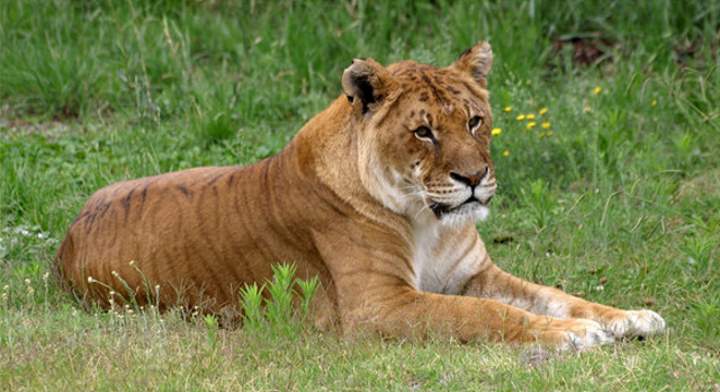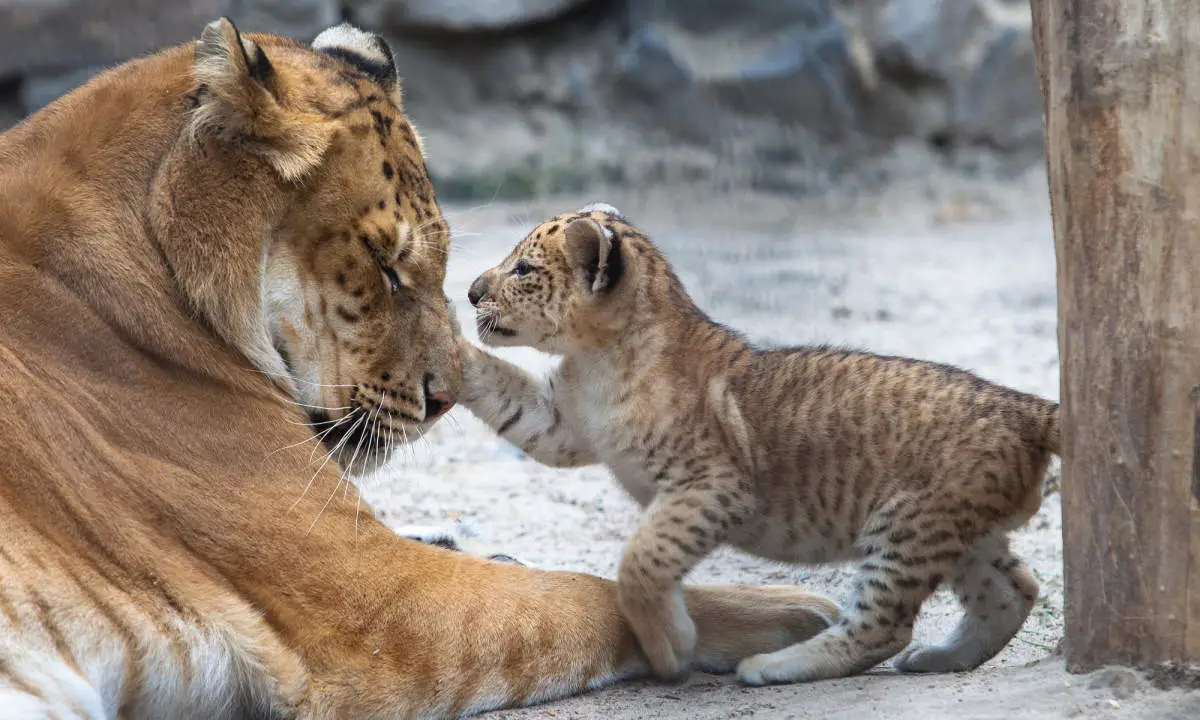The liger, a hybrid offspring of a male lion and a female tiger, holds the title of the largest cat to ever roam the Earth, surpassing even the extinct giants of the feline world. Not even the formidable saber-toothed tiger (see notes 1 at the bottom of this post), renowned for its strength and size, could rival the sheer mass of a liger. These magnificent creatures, a blend of the two most iconic big cats, are rare and fascinating. Here are 20 incredible facts that will deepen your appreciation of the liger’s extraordinary characteristics.
1. The Liger is the Largest Cat That Ever Lived on Earth
Ligers typically grow much larger than either of their parent species, lions or tigers. In fact, they are among the largest cats to have ever lived, surpassing even the mighty saber-toothed tiger (Smilodon populator). Male ligers can reach impressive sizes, often growing up to 3.6 meters (11.8 feet) in length and weighing over 400 kilograms (880+ lbs).
The Guinness World Records recognizes a male liger named Hercules as the largest non-obese living cat, weighing an incredible 418.2 kg (922 lbs). However, even Hercules was outmatched by a male liger named Nook, who lived in captivity in the U.S. Nook weighed over 550 kg (1,213 lbs) and at one point reportedly reached a staggering 615 kg (1,400 lbs), an astonishing weight even by liger standards.

For comparison, the heaviest lions and tigers in captivity have never exceeded 500 kg (1,100 lbs). Nook, when standing on his hind legs, could reach up to 4 meters (13 feet) in height. Sadly, Nook was euthanized at the age of 21 in 2007 due to cancer. He is believed to be the largest cat to have ever walked the Earth.

Why Ligers Grow Bigger Than Both Lions and Tigers: The Science Behind Their Massive Size
Ligers grow larger than both lions and tigers due to a phenomenon known as hybrid vigor (or heterosis), which occurs when the offspring of two different species exhibit greater size, strength, or other traits than either parent. In the case of ligers, the genetic combination of a male lion and a female tiger results in an unusually large animal.
This size increase is partly due to the absence of certain growth-inhibiting factors. In lions, males inherit a growth-limiting gene from their mothers that controls their size. In tigers, the same gene is present in both parents. When a male lion mates with a female tiger to produce a liger, this growth-limiting factor is absent, allowing the liger to reach massive proportions.
Additionally, male ligers tend to inherit the lion’s social nature and tiger’s affinity for food, which may contribute to their larger size as they continue to grow and eat more. Female ligers, on the other hand, tend to be smaller than males but still surpass the size of their parents. This growth anomaly is a key reason why ligers often become the largest cats in existence.
They Do Not Grow Throughout Their Lives
Ligers are often mistakenly believed to continue growing throughout their lives due to hormonal imbalances. However, this isn’t the case. Ligers simply experience more growth during their early years and take longer to reach their full adult size. After around six years of age, further growth in shoulder height and body length ceases, just like in lions and tigers. While their impressive size may seem to suggest endless growth, ligers follow a similar growth pattern to their parent species, only on a larger scale.
2. The Liger is the Hybrid Offspring of a Male Lion and a Female Tiger
The liger is a fascinating hybrid, born from the union of a male lion and a female tiger, blending the traits of two of the most iconic big cats. This unique pairing results in a creature that inherits characteristics from both its parents, yet develops into something entirely its own.
The name “liger” is a combination of “lion” and “tiger,” reflecting its hybrid origins.
3. Ligers Can Reproduce
Unlike many hybrid animals, ligers can actually reproduce by cross-breeding with lions or tigers. For example, a li-liger has a lion father and a liger mother, while a ti-liger has a tiger father and a liger mother. This makes ligers unique among hybrids.
Male ligers, however, are infertile due to lower testosterone levels and reduced sperm counts, but female ligers remain fertile. Despite their infertility, male ligers are still sexually active.

4. They Enjoy Swimming!
Unlike most lions, ligers are not afraid of water – in fact, they love it! Much like their tiger mothers, ligers enjoy swimming and playing in water. This behavior is inherited from the tiger side of their lineage, as tigers are known for being strong swimmers who frequently bathe and hunt in rivers and lakes.
Ligers can often be seen cooling off in the water, especially in warm climates where water provides relief from the heat. Their powerful, muscular bodies make them natural swimmers, and they seem to embrace the activity with great enthusiasm. This unique blend of lion and tiger traits -where they share the lion’s social nature and the tiger’s love for water- makes ligers fascinating creatures to observe.
Interestingly, this love for water sets them apart from most lions, who typically avoid large bodies of water. It’s just another example of how ligers combine traits from both parent species in surprising ways.

5. Ligers Only Exist in Captivity
Ligers, being the hybrid offspring of lions and tigers, only exist in captivity because their parent species live on different continents and have vastly different habitats. Tigers, for the most part, are native to Asia, while lions currently inhabit primarily Africa. These geographical separations prevent lions and tigers from naturally encountering each other in the wild.
The only place in the world where both species can be found close together is India’s Gir Forest, home to around 600 Asiatic lions. However, even here, lions and tigers rarely, if ever, interact. They tend to inhabit different territories within the forest and show little to no interest in one another, making natural cross-breeding impossible.
As a result, ligers are only bred in captivity, where their pairing is arranged by humans. This unique hybridization can only happen in zoos or private collections, where male lions and female tigers are kept together. Despite their majestic size and hybrid appeal, the existence of ligers in the wild is impossible due to the natural separation of their parent species’ habitats and behaviors.
This phenomenon underscores how ligers are a product of human intervention rather than a natural occurrence, which raises important ethical questions about breeding these hybrids solely for human curiosity.

6. Ligers Are Extremely Social Animals
Ligers inherit some of the best traits from both of their parent species. For instance, like tigers, they enjoy swimming, and, like lions, they are very social animals. This social nature makes them more likely to interact and bond with other big cats, a trait inherited from their lion lineage, where living in prides fosters social behaviors.
Ligers are also known to be friendly toward their caretakers, displaying a calmer and more approachable demeanor compared to other big cats. Unlike male lions, who can be territorial and aggressive, ligers tend to have mild, less confrontational personalities, making them appear more docile. Their affectionate nature allows them to form strong bonds with humans, and they often seek attention and interaction.
Experts note that ligers’ less aggressive tendencies make them easier to manage in captivity than lions or tigers, though their immense size still requires careful handling. While they may have a gentle disposition, they remain powerful animals, so caretakers must always be mindful of their strength.

7. Ligers Look Like Both Lions and Tigers
Ligers are a fascinating blend of their parent species, exhibiting physical traits from both lions and tigers. They typically have faint tiger-like stripes against a lion-like tawny or golden background. These stripes are often less pronounced than those of a purebred tiger, giving the liger a unique, subtle appearance.
Additionally, some ligers may inherit faint rosettes from their lion parent, especially since lion cubs are born with these spots, and some adult lions retain faint markings. This adds another layer of complexity to their appearance, making them resemble a mix of both species.
Male ligers also grow a mane, similar to a male lion. However, their mane tends to be shorter and less prominent than that of a lion, often appearing scruffy or less defined. The mane doesn’t cover the same extensive area as a lion’s, giving the male liger a distinct, hybrid look.
This blend of features makes ligers visually striking and easily distinguishable from both lions and tigers. Their combination of stripes, rosettes, and manes creates a hybrid appearance that captivates those lucky enough to see them in person.

8. Liger Cubs Are Born Through a Normal Delivery Process
Liger cubs, despite growing into the largest cats on Earth, are born roughly the same size as tiger cubs, making their birth relatively uncomplicated for their tigress mothers. According to the Liger World website, a female tiger (tigress) can deliver liger cubs through a natural birthing process without any extraordinary assistance.

Contrary to the common myth that the size of the liger cub could pose a risk to the mother during delivery, this isn’t the case. At birth, the liger cubs are comparable in size to their tiger counterparts, so there is no undue stress or danger to the mother. This normal birthing process allows the tigress to give birth without the complications associated with the cub’s future size.
The real growth of ligers happens after birth, during their developmental years. While they eventually grow much larger than both their parents, they start out small, much like any other big cat cub. This normal start to life helps dispel the myth that liger births are inherently dangerous for the tigress.
9. Liger Cubs Grow at a Rate of 0.5 kg Every Day
Liger cubs have the fastest growth rate among all big cats, making them remarkable for their rapid development. On average, a liger cub grows at a rate of 0.5 kg (1.1 lb) every day, which is significantly faster than the growth of lion or tiger cubs. This rapid weight gain contributes to the immense size that ligers are known for as adults.
By the end of their first year, a liger cub (which is now a young liger) can weigh up to 165 kg (363 lbs), almost as large as a fully grown male lion! This accelerated growth rate sets them apart from their parent species, which grow at a more moderate pace.

By the time they reach 3 years of age, ligers can weigh over 320 kg (705 lbs), far surpassing their parents’ typical adult weights. It is this rapid early growth that propels ligers to become the largest cats on the planet, with some males eventually reaching weights of over 400 kg (880 lbs). Despite their size, they remain playful and social animals, making them both impressive and fascinating creatures.
10. Their Heads and Claws Are Huge!
Ligers not only stand out for their immense size but also for the sheer scale of their individual features. A liger’s head is exceptionally large, typically measuring around 70 cm (27.56 inches) in width – about twice as wide as the heads of their parent species, lions and tigers!
For comparison, the average lion’s head measures approximately 35 cm (15 inches) across, and a tiger’s head is similarly sized at around 35 cm (13.78 inches). This impressive difference in head size underscores the enormous physical presence of a liger, making it one of the most visually striking big cats.
Their claws are just as remarkable. A liger’s claws can grow up to 5 cm (2 inches) long-nearly double the length of a lion’s or tiger’s claws, which typically measure around 2.5 cm (1 inch). These massive claws are a reflection of the liger’s overall size and strength, giving them formidable physical power. Despite this, ligers often maintain gentle dispositions, particularly in captivity, but their impressive features are a constant reminder of their hybrid might.
The enormous size of their heads and claws highlights the unique hybrid vigor that allows ligers to outgrow their parent species in every dimension.

11. They have the strongest bite of all felids
Ligers possess the strongest bite force of any felid, measuring around 900 pounds (4,000 N) at the tips of their canines. This extraordinary bite strength surpasses that of both lions and tigers, which have bite forces of around 400 pounds and 450 pounds respectively.
The liger’s powerful bite is a direct result of its massive size and muscular structure, allowing it to exert tremendous pressure when biting down. This formidable bite force is crucial for large cats in the wild when subduing prey, although ligers, being captive animals, don’t need to rely on it for survival. While ligers are not found in the wild, their bite strength and physical dominance would make them an apex predator if they were, capable of taking down even the largest prey with ease.

12. Their Roar Sounds Like a Lion’s, But Even Stronger
Ligers have a roar that closely resembles that of a lion, but with an even more powerful and resonant sound due to their immense size. The roar of a liger can be heard over long distances, similar to a lion’s roar, but it often sounds deeper and more thunderous, leaving a strong impression on anyone who hears it.
In addition to their lion-like roar, ligers also exhibit vocalizations similar to tigers. For example, they “cuff” or “chuff” like tigers, a sound made by forcing air through the nostrils in a friendly, non-aggressive manner. This duality in their vocal behaviors reflects their hybrid nature, blending traits from both of their parent species. The combination of the lion’s commanding roar and the tiger’s gentle chuffing makes the liger’s vocal range unique among big cats.
13. They Are Fast and Agile Despite Their Size
Although ligers are the largest big cats on Earth, their enormous size doesn’t compromise their speed and agility. Thanks to their powerful muscles, ligers are surprisingly fast and capable of impressive bursts of speed. This strength allows them to move with agility that rivals both lions and tigers, despite their massive frames, which can exceed 400 kg (880 lbs) in some cases.
Ligers combine the agility of tigers, which are known for their quick and graceful movements in the wild, with the strength of lions, making them capable of both speed and power. This combination of traits allows ligers to cover short distances quickly, showcasing their muscular endurance.
While they are primarily found in captivity and don’t have the same survival challenges as wild cats, their agility would serve them well in the wild, making them capable hunters. Their physical capabilities, including speed and agility, are a direct reflection of their hybrid genetics, blending the best traits of both parent species.
According to Liger World, Hercules could run up to 50 mph (approximately 80 km/h) for short bursts, which is very fast among the big cats. This speed makes ligers the second-fastest big cats, just after Cheetah which can reach speeds of up to 98.1 km/hr (61 mph).

14. They Sleep a Lot
Like all big cats, ligers are known for their long hours of rest, often spending up to 20 hours a day sleeping or lounging. This behavior is typical among large felines, such as lions and tigers, who conserve energy for short bursts of intense activity like hunting or playing. For ligers, despite their immense size and strength, resting is a vital part of their daily routine.
Ligers inherit their sleep habits from both parent species, with lions particularly known for their extended periods of inactivity. This restful behavior allows their bodies to recover and grow, especially given the physical demands of supporting their large frames.
In captivity, ligers follow the same pattern, frequently napping in shaded areas or lounging peacefully. However, due to their sedentary lifestyle and lack of natural hunting, ligers in captivity can easily become overweight or even obese without careful management.

15. They are Hypercarnivores
Like all cats, ligers are hypercarnivores, meaning their diet consists primarily of meat. On average, an adult liger consumes between 9 and 11 kilograms (20-25 pounds) of meat each day to maintain its enormous size and strength. Their diet typically includes beef, chicken, or other meats provided in captivity, mimicking the hunting habits of their parent species in the wild.
Despite their largely carnivorous diet, ligers, like many cats, are known to occasionally nibble on grass. This behavior is not about nutrition but may help with digestion or to induce vomiting if they’ve ingested something that upsets their stomach. While meat remains the central focus of their diet, the occasional consumption of grass shows that ligers share this quirky trait with other felines.
Their hypercarnivorous nature, combined with their massive size, makes their dietary needs much larger than those of lions or tigers, reinforcing the importance of a meat-rich diet for these extraordinary animals.
16. They Dominate Lions and Tigers
Due to their immense size and strength, ligers hold a dominant position over both lions and tigers in captivity. Weighing far more and often standing taller than their parent species, ligers easily overpower other big cats. Their sheer physical presence is enough to make even the most formidable lions or tigers back down in encounters.
According to experts and caretakers, lions and tigers tend to retreat when faced with even the slightest sign of aggression from a liger. This natural deference is largely due to the liger’s superior strength and mass, which can make them an intimidating force in any interaction. While ligers are generally known for their mild temperaments, their potential for dominance is unmistakable when tensions rise.
This dominance doesn’t just stem from their size-it’s a combination of power, agility, and confidence, making them a commanding presence among other big cats. Even in social settings, ligers tend to establish themselves as the dominant figure, reinforcing their role as the top cat in their environment.

17. To Date, Only One Person Has Been Killed by a Liger
In 2008, a tragic incident occurred at an animal sanctuary in Oklahoma when 32-year-old caretaker Peter Getz was mauled by a liger. Despite the sanctuary’s strict protocol to never enter the enclosures of the big cats, Getz went inside the liger’s habitat, leading to the fatal encounter. The liger attacked Getz, mauling him on the neck and back.
Although other handlers quickly intervened and rescued Getz from the enclosure, he suffered severe injuries and was rushed to the hospital. Unfortunately, despite medical efforts, Getz succumbed to his injuries the following day.
This remains the only recorded incident where a liger has fatally attacked a human. Ligers are generally known for their calm and non-aggressive behavior, especially in captivity, but this tragic event underscores the inherent danger of working with such large and powerful animals. Even with their typically mild temperaments, ligers, like all big cats, must be handled with caution and respect.
18. Shasta, a female was the longest-living liger ever
Shasta, a female liger who lived her entire life at the Hogle Zoo in Utah, holds the record as the longest-living liger in history. Born on May 14, 1948, Shasta captivated zoo visitors for over two decades with her majestic appearance and gentle nature. She lived a remarkable 24 years, far surpassing the average lifespan of most big cats in captivity.
During her lifetime, Shasta became a beloved symbol of the zoo and was one of the few ligers in existence at the time. Her longevity was impressive, as lions and tigers typically live between 10 to 20 years in the wild and slightly longer in captivity.
Shasta passed away in 1972, and to this day, no other liger has lived longer. Her record still stands, making her a remarkable figure in the world of big cats.
19. They don’t have a scientific name
Unlike their parent species, the lion (Panthera leo) and the tiger (Panthera tigris), ligers do not have a scientific name. As hybrids created through the crossbreeding of two distinct species, ligers are not classified as their own species and thus lack a formal taxonomic designation. Since ligers are born only in captivity and do not exist naturally in the wild, they fall outside traditional biological classifications used for species that have evolved naturally over time.
The naming conventions in taxonomy are reserved for species that reproduce within their own populations, whereas hybrids like the liger do not fit neatly into these categories. As such, ligers inherit traits from both of their parent species but are considered artificial creations, with no official place in the natural taxonomy of big cats.
20. Ligers do not have a poor immune system
Again, a common myth. Their immune system is not weak. They are as healthy as any other big cat.
Notes
- Saber-toothed tiger is actually not a correct term, but it’s quite common. Saber-Toothed Cat is a more accurate term since Smilodon was not closely related to tigers.

Related: Hybrid Big Cats
Sources
- Liger on Wikipedia
- Liger Facts on the Big Cat Rescue website
- Interesting Liger Facts on the Liger Facts website
- Liger facts on the Fact Animal website
- Liger Facts on the Liger World website
- Moon Landings: All-Time List [1966-2025] - February 2, 2025
- What Is Max-Q and Why Is It Important During Rocket Launches? - January 16, 2025
- Top 10 Tallest Rockets Ever Launched [2025 Update] - January 16, 2025
